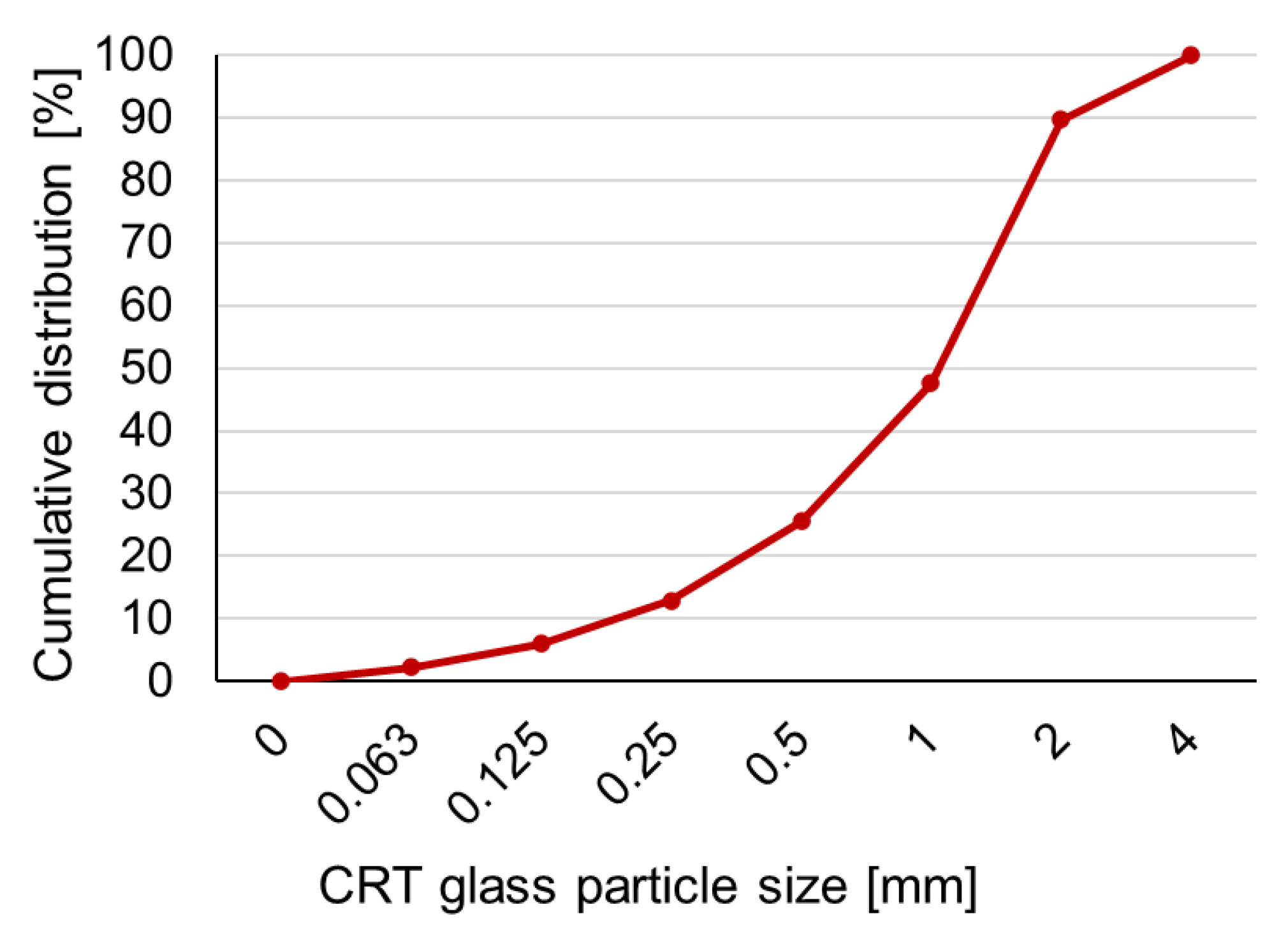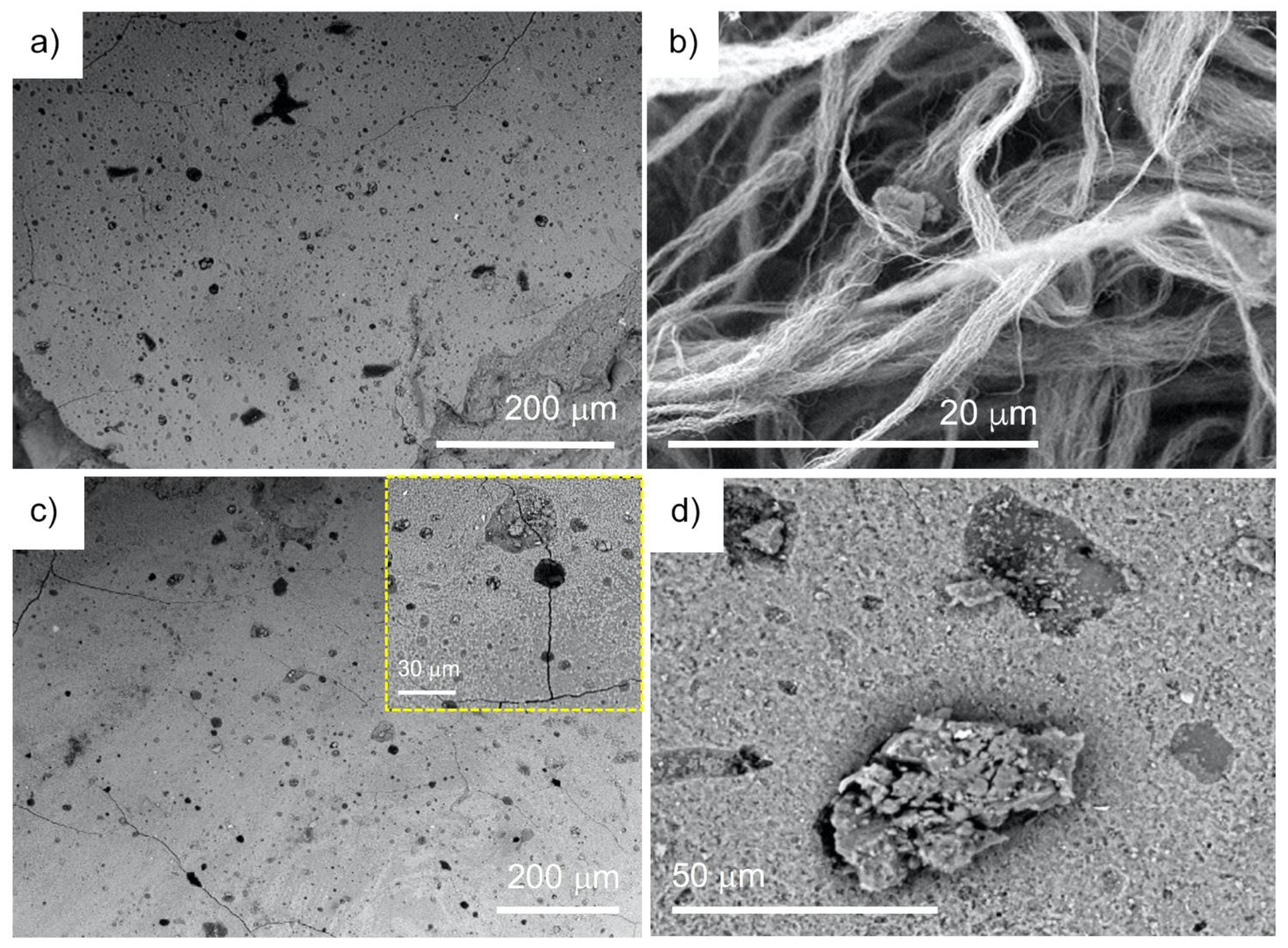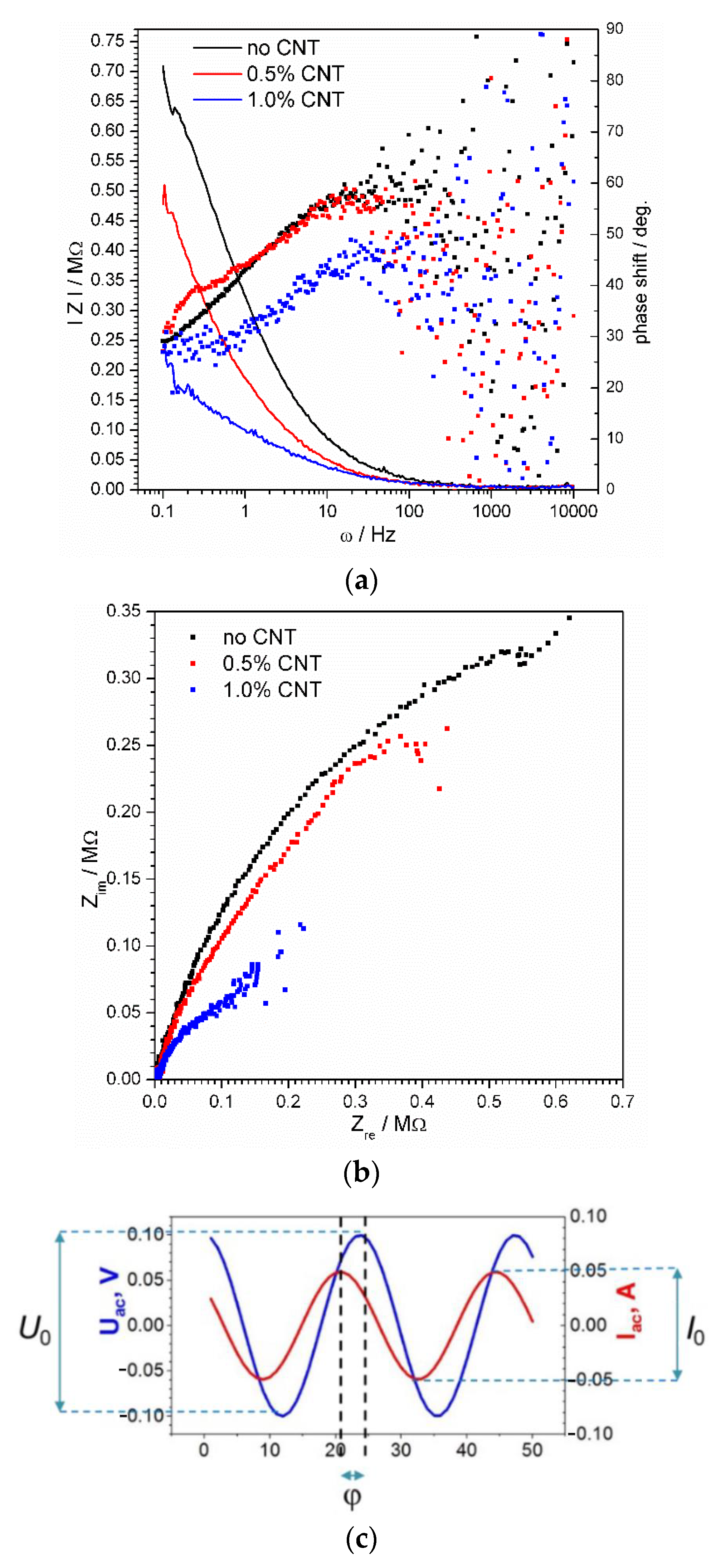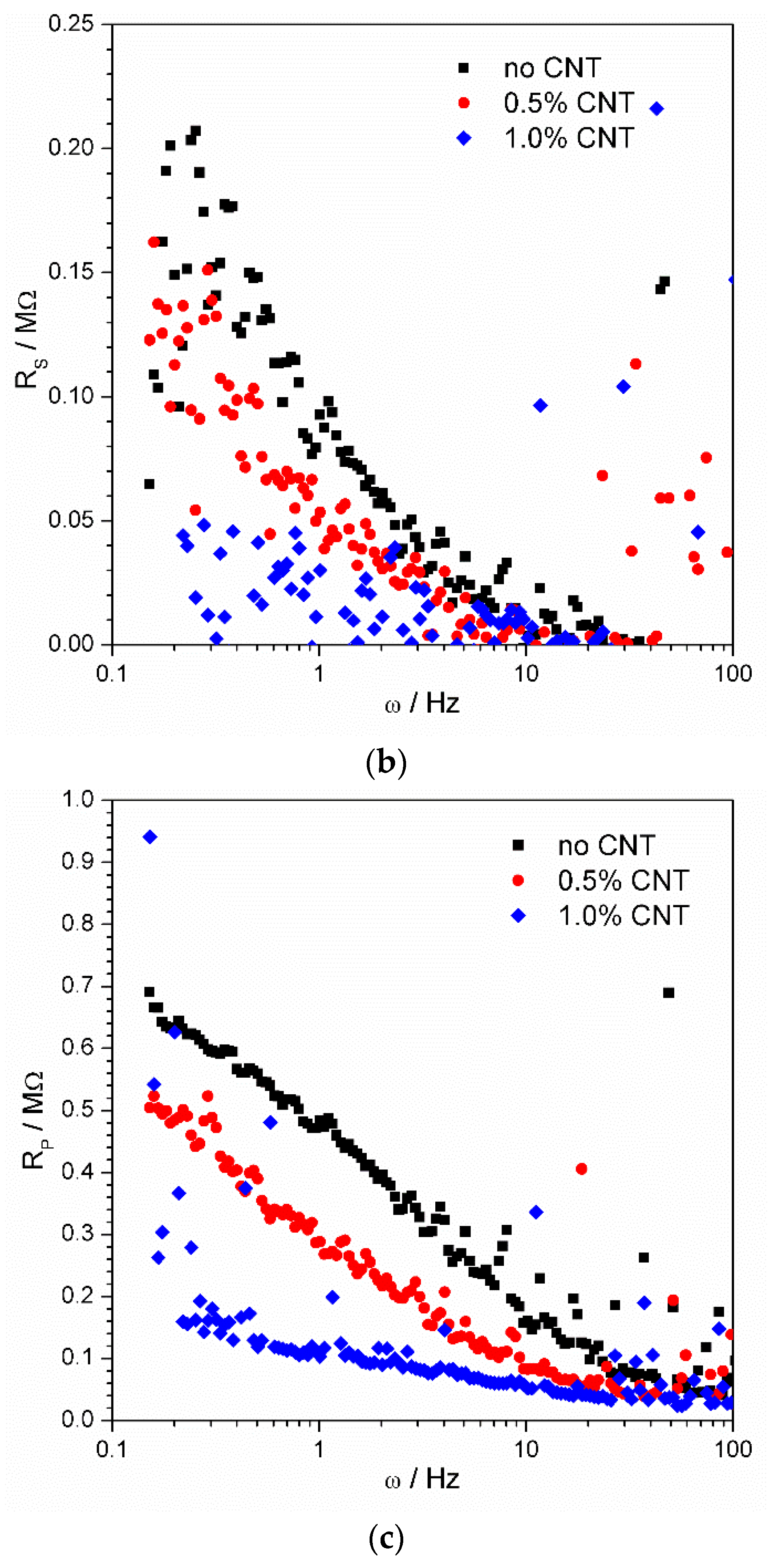Electrical Properties of the Carbon Nanotube-Reinforced Geopolymer Studied by Impedance Spectroscopy
Abstract
:1. Introduction
2. Materials and Methods
2.1. Synthesis and Characterization of Ultra-Long CNTs (UL-MWCNTs)
2.2. Carbon Nanotube-Reinforced Geopolymer
2.3. Impedance Spectroscopy Methodology
3. Results
3.1. Carbon Nanotube-Reinforced Geopolymer—Mechanical Properties
3.2. Microstructure
3.3. Impedance Spectroscopy
4. Discussion
5. Conclusions
Author Contributions
Funding
Institutional Review Board Statement
Informed Consent Statement
Data Availability Statement
Acknowledgments
Conflicts of Interest
References
- Chen, P.-W.; Chung, D.D.L. Carbon Fiber Reinforced Concrete for Smart Structures Capable of Non-Destructive Flaw Detection. Smart Mater. Struct. 1993, 2, 22–30. [Google Scholar] [CrossRef]
- Chen, P.-W.; Chung, D.D.L. Carbon-Fiber-Reinforced Concrete as an Intrinsically Smart Concrete for Damage Assessment during Dynamic Loading. J. Am. Ceram. Soc. 1995, 78, 816–818. [Google Scholar] [CrossRef]
- Chen, P.-W.; Chung, D.D.L. Concrete as a New Strain/Stress Sensor. Compos. Part B Eng. 1996, 27, 11–23. [Google Scholar] [CrossRef]
- Fu, X.; Lu, W.; Chung, D.D.L. Improving the Strain-Sensing Ability of Carbon Fiber-Reinforced Cement by Ozone Treatment of the Fibers 11Communicated by D.M. Roy. Cem. Concr. Res. 1998, 28, 183–187. [Google Scholar] [CrossRef]
- Kim, G.M.; Yang, B.J.; Cho, K.J.; Kim, E.M.; Lee, H.K. Influences of CNT Dispersion and Pore Characteristics on the Electrical Performance of Cementitious Composites. Compos. Struct. 2017, 164, 32–42. [Google Scholar] [CrossRef]
- D’Alessandro, A.; Rallini, M.; Ubertini, F.; Materazzi, A.L.; Kenny, J.M. Investigations on Scalable Fabrication Procedures for Self-Sensing Carbon Nanotube Cement-Matrix Composites for SHM Applications. Cem. Concr. Compos. 2016, 65, 200–213. [Google Scholar] [CrossRef]
- Lim, K.M.; Lee, J.H. Electrical Conductivity and Compressive Strength of Cement Paste with Multiwalled Carbon Nanotubes and Graphene Nanoplatelets. Appl. Sci. 2022, 12, 1160. [Google Scholar] [CrossRef]
- Materazzi, A.L.; Ubertini, F.; D’Alessandro, A. Carbon Nanotube Cement-Based Transducers for Dynamic Sensing of Strain. Cem. Concr. Compos. 2013, 37, 2–11. [Google Scholar] [CrossRef]
- Torabian Isfahani, F.; Li, W.; Redaelli, E. Dispersion of Multi-Walled Carbon Nanotubes and Its Effects on the Properties of Cement Composites. Cem. Concr. Compos. 2016, 74, 154–163. [Google Scholar] [CrossRef]
- Le, J.-L.; Du, H.; Pang, S.D. Use of 2D Graphene Nanoplatelets (GNP) in Cement Composites for Structural Health Evaluation. Compos. Part B Eng. 2014, 67, 555–563. [Google Scholar] [CrossRef]
- Yoo, D.-Y.; You, I.; Lee, S.-J. Electrical Properties of Cement-Based Composites with Carbon Nanotubes, Graphene, and Graphite Nanofibers. Sensors 2017, 17, 1064. [Google Scholar] [CrossRef] [PubMed]
- Ubertini, F.; D’Alessandro, A.; Materazzi, A.L.; Laflamme, S.; Downey, A. Novel Nanocomposite Clay Brick for Strain Sensing in Structural Masonry. In Proceedings of the 2017 IEEE International Conference on Environment and Electrical Engineering and 2017 IEEE Industrial and Commercial Power Systems Europe (EEEIC/I CPS Europe), Milan, Italy, 6 June 2017; pp. 1–4. [Google Scholar]
- Davidovits, J.; Comrie, D.; Paterson, J.; Ritcey, D. Geopolymeric Concretes for Environmental Protection. Concr. Int. 1990, 12, 30–39. [Google Scholar]
- Provis, J.L. Alkali-Activated Materials. Cem. Concr. Res. 2018, 114, 40–48. [Google Scholar] [CrossRef]
- Górski, M.; Wielgus, N.; Loska, K.; Kozioł, M.; Landrat, M.; Ścierski, W.; Pikoń, K. Characteristics of Metakaolin-Based Geopolymer with Cathode Ray Tube Glass. Polymers 2021, 13, 1149. [Google Scholar] [CrossRef]
- Payakaniti, P.; Pinitsoontorn, S.; Thongbai, P.; Amornkitbamrung, V.; Chindaprasirt, P. Electrical Conductivity and Compressive Strength of Carbon Fiber Reinforced Fly Ash Geopolymeric Composites. Constr. Build. Mater. 2017, 135, 164–176. [Google Scholar] [CrossRef]
- Saafi, M.; Piukovics, G.; Ye, J. Hybrid Graphene/Geopolymeric Cement as a Superionic Conductor for Structural Health Monitoring Applications. Smart Mater. Struct. 2016, 25, 105018. [Google Scholar] [CrossRef]
- Bi, S.; Liu, M.; Shen, J.; Hu, X.M.; Zhang, L. Ultrahigh Self-Sensing Performance of Geopolymer Nanocomposites via Unique Interface Engineering. ACS Appl. Mater. Interfaces 2017, 9, 12851–12858. [Google Scholar] [CrossRef]
- Rovnaník, P.; Mizerová, C.; Kusák, I.; Schmid, P. Self-Sensing Properties of Alkali-Activated Slag Composite with Carbon Black during Bending Test. In Binders, Materials and Technologies in Modern Construction V; Trans Tech Publications Ltd.: Kapellweg, Switzerland, 2019; Volume 296, pp. 167–172. [Google Scholar]
- Rovnaník, P.; Kusák, I.; Bayer, P.; Schmid, P.; Fiala, L. Electrical and Self-Sensing Properties of Alkali-Activated Slag Composite with Graphite Filler. Materials 2019, 12, 1616. [Google Scholar] [CrossRef] [Green Version]
- Su, Z.; Hou, W.; Sun, Z. Recent Advances in Carbon Nanotube-Geopolymer Composite. Constr. Build. Mater. 2020, 252, 118940. [Google Scholar] [CrossRef]
- Da Luz, G.; Gleize, P.J.P.; Batiston, E.R.; Pelisser, F. Effect of Pristine and Functionalized Carbon Nanotubes on Microstructural, Rheological, and Mechanical Behaviors of Metakaolin-Based Geopolymer. Cem. Concr. Compos. 2019, 104, 103332. [Google Scholar] [CrossRef]
- Rovnaník, P.; Šimonová, H.; Topolář, L.; Schmid, P.; Keršner, Z. Effect of Carbon Nanotubes on the Mechanical Fracture Properties of Fly Ash Geopolymer. Procedia Eng. 2016, 151, 321–328. [Google Scholar] [CrossRef] [Green Version]
- Azeem, M.; Junaid, M.T.; Saleem, M.A. Correlated Strength Enhancement Mechanisms in Carbon Nanotube Based Geopolymer and OPC Binders. Constr. Build. Mater. 2021, 305, 124748. [Google Scholar] [CrossRef]
- Maho, B.; Sukontasukkul, P.; Sua-Iam, G.; Sappakittipakorn, M.; Intarabut, D.; Suksiripattanapong, C.; Chindaprasirt, P.; Limkatanyu, S. Mechanical Properties and Electrical Resistivity of Multiwall Carbon Nanotubes Incorporated into High Calcium Fly Ash Geopolymer. Case Stud. Constr. Mater. 2021, 15, e00785. [Google Scholar] [CrossRef]
- Abbasi, S.M.; Ahmadi, H.; Khalaj, G.; Ghasemi, B. Microstructure and Mechanical Properties of a Metakaolinite-Based Geopolymer Nanocomposite Reinforced with Carbon Nanotubes. Ceram. Int. 2016, 42, 15171–15176. [Google Scholar] [CrossRef]
- Jittabut, P.; Horpibulsuk, S. Physical and Microstructure Properties of Geopolymer Nanocomposite Reinforced with Carbon Nanotubes. Mater. Today Proc. 2019, 17, 1682–1692. [Google Scholar] [CrossRef]
- Christensen, B.J.; Coverdale, T.; Olson, R.A.; Ford, S.J.; Garboczi, E.J.; Jennings, H.M.; Mason, T.O. Impedance Spectroscopy of Hydrating Cement-Based Materials: Measurement, Interpretation, and Application. J. Am. Ceram. Soc. 1994, 77, 2789–2804. [Google Scholar] [CrossRef]
- Olson, R.A.; Christensen, B.J.; Coverdale, R.T.; Ford, S.J.; Moss, G.M.; Jennings, H.M.; Mason, T.O.; Garboczi, E.J. Interpretation of the Impedance Spectroscopy of Cement Paste via Computer Modelling—Part III Microstructural Analysis of Frozen Cement Paste. J. Mater. Sci. 1995, 30, 5078–5086. [Google Scholar] [CrossRef]
- Seong, K.-P.; Jeon, S.-Y.; Singh, B.; Hwang, J.-H.; Song, S.-J. Comparative Study of an Experimental Portland Cement and ProRoot MTA by Electrochemical Impedance Spectroscopy. Ceram. Int. 2014, 40, 1741–1746. [Google Scholar] [CrossRef]
- Ribeiro, D.V.; Abrantes, J.C.C. Application of Electrochemical Impedance Spectroscopy (EIS) to Monitor the Corrosion of Reinforced Concrete: A New Approach. Constr. Build. Mater. 2016, 111, 98–104. [Google Scholar] [CrossRef]
- EN 196-1; Method of Testing Cement—Part 1: Determination of Strength. European Committee for Standardization: Brussels, Belgium, 2016.
- Vladikova, D. Selectivity Study of the Differential Impedance Analysis—Comparison with the Complex Non-Linear Least-Squares Method. Electrochim. Acta 2002, 47, 2943–2951. [Google Scholar] [CrossRef]
- Vladikova, D.; Stoynov, Z. Secondary Differential Impedance Analysis—A Tool for Recognition of CPE Behavior. J. Electroanal. Chem. 2004, 572, 377–387. [Google Scholar] [CrossRef]
- Vladikova, D.; Stoynov, Z.; Viviani, M. Application of the Differential Impedance Analysis for Investigation of Electroceramics. J. Eur. Ceram. Soc. 2004, 24, 1121–1127. [Google Scholar] [CrossRef]
- Ebbesen, T.W.; Lezec, H.J.; Hiura, H.; Bennett, J.W.; Ghaemi, H.F.; Thio, T. Electrical Conductivity of Individual Carbon Nanotubes. Nature 1996, 382, 54–56. [Google Scholar] [CrossRef]
- Du, F.; Scogna, R.C.; Zhou, W.; Brand, S.; Fischer, J.E.; Winey, K.I. Nanotube Networks in Polymer Nanocomposites: Rheology and Electrical Conductivity. Macromolecules 2004, 37, 9048–9055. [Google Scholar] [CrossRef]






| Oxide Composition | Metakaolin | CRT Glass |
|---|---|---|
| SiO2 | 53.12 | 76.10 |
| Al2O3 | 42.14 | 1.37 |
| K2O | 0.73 | 2.36 |
| TiO2 | 0.64 | 0.12 |
| Fe2O3 | 0.45 | 0.38 |
| CaO | 0.44 | 5.24 |
| MgO | 0.26 | 1.64 |
| H2O− | 0.22 | - |
| Na2O | 0.09 | 6.25 |
| P2O5 | 0.03 | - |
| MnO | 0.01 | - |
| BaO | - | 2.62 |
| PbO | - | 1.61 |
| SrO | - | 1.42 |
| SO3 | - | 0.55 |
| ZrO2 | - | 0.28 |
| ZnO | - | 0.05 |
| As2O3 | - | 0.01 |
| Mixture | Metakaolin (kg/m3) | CRT Glass(kg/m3) | Sodium Silicate (kg/m3) | Sodium Hydroxide (kg/m3) | Carbon Nanotubes (kg/m3) |
|---|---|---|---|---|---|
| No CNT | 898 | 898 | 449 | 225 | - |
| 0.5% CNT | 898 | 898 | 449 | 225 | 4.49 |
| 1.0% CNT | 898 | 898 | 449 | 225 | 8.98 |
| no CNT | 0.5% CNT | 1.0% CNT | |
|---|---|---|---|
| Flexural strength (MPa) | 6.2 | 5.3 | 5.8 |
| Compressive strength (MPa) | 66.6 | 60.7 | 59.0 |
| Density | No CNT | 0.5% CNT | 1.0% CNT |
|---|---|---|---|
| (kg/m3) | 2010 | 1970 | 1970 |
Publisher’s Note: MDPI stays neutral with regard to jurisdictional claims in published maps and institutional affiliations. |
© 2022 by the authors. Licensee MDPI, Basel, Switzerland. This article is an open access article distributed under the terms and conditions of the Creative Commons Attribution (CC BY) license (https://creativecommons.org/licenses/by/4.0/).
Share and Cite
Górski, M.; Czulkin, P.; Wielgus, N.; Boncel, S.; Kuziel, A.W.; Kolanowska, A.; Jędrysiak, R.G. Electrical Properties of the Carbon Nanotube-Reinforced Geopolymer Studied by Impedance Spectroscopy. Materials 2022, 15, 3543. https://doi.org/10.3390/ma15103543
Górski M, Czulkin P, Wielgus N, Boncel S, Kuziel AW, Kolanowska A, Jędrysiak RG. Electrical Properties of the Carbon Nanotube-Reinforced Geopolymer Studied by Impedance Spectroscopy. Materials. 2022; 15(10):3543. https://doi.org/10.3390/ma15103543
Chicago/Turabian StyleGórski, Marcin, Paweł Czulkin, Natalia Wielgus, Sławomir Boncel, Anna W. Kuziel, Anna Kolanowska, and Rafał G. Jędrysiak. 2022. "Electrical Properties of the Carbon Nanotube-Reinforced Geopolymer Studied by Impedance Spectroscopy" Materials 15, no. 10: 3543. https://doi.org/10.3390/ma15103543
APA StyleGórski, M., Czulkin, P., Wielgus, N., Boncel, S., Kuziel, A. W., Kolanowska, A., & Jędrysiak, R. G. (2022). Electrical Properties of the Carbon Nanotube-Reinforced Geopolymer Studied by Impedance Spectroscopy. Materials, 15(10), 3543. https://doi.org/10.3390/ma15103543







